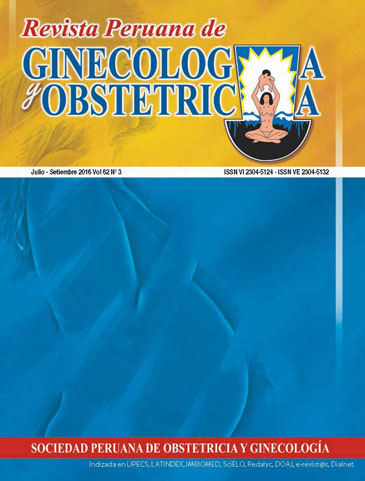Prenatal diagnosis of chromosomal abnormalities Chorionic vilous sampling and amniocentesis for fetal karyoty ping
DOI:
https://doi.org/10.31403/rpgo.v62i1922Abstract
Introduction: Early prenatal diagnosis of chromosomal abnormalities requires invasive techniques, including chorionic villous sampling (CVS) and amniocentesis (AMC) in order to acquire, culture and kayotype cells from fetuses at high risk for these abnormalities based on sonographic and biochemical markers present after week 11. We report our experience through June 2016.Design: Descriptive, longitudinal study. Setting: Instituto Latinoamericano de Salud Reproductiva (ILSAR), Lima, Peru. Participants: First and second trimester of pregnancy fetuses. Interventions: Results of the study of 400 first and second trimester fetuses at high risk for chromosomal abnormalities (greater than 1/270 initially or 1/100 starting in 2012) based on Spain Fetal Test database and the results of biochemical markers (combined risk). Fetal karyotype analysis was performed on samples obtained from 338 genetic AMC and 62 CVS from January 2003 to June 2016. Main outcomes measures: Presence of ultrasound markers and normality of karyotypes. Results: The sonographic markers of complications identified most frequently were the following: cystic hygroma (35.8%), increased nuchal translucency (13%), abnormal ductus venosus waveforms (8.5%), two or more markers associated with fetal anomalies (13.7%). Out of the 400 samples studied, 141 (35%) had abnormal karyotypes: 64 (45%) trisomy 21, 35 (25%) trisomy 18, 21 (15%) monosomy X, 7 (5%) trisomy 13, and 14 (10%) other abnormalities. No major complications were attributed to the invasive procedure. Conclusions: Among these fetuses at high risk for chromosomal abnormalities, 35% had an abnormal karyotype. The most frequent chromosomal abnormalities were trisomies 21 and 18, followed by monosomy X. Cystic hygroma, increased nuchal translucency, and the presence of 2 or more markers associated with fetal anomalies were the most common findings in determining the sonographic risk of abnormalities. Cystic hygroma showed the highest predictive value for chromosomal abnormalities.Downloads
Download data is not yet available.
Downloads
Published
2016-10-18
How to Cite
Huamán G., M., Quiroga de Michelena, M. I., St. Martin, B., & Huamán J., M. (2016). Prenatal diagnosis of chromosomal abnormalities Chorionic vilous sampling and amniocentesis for fetal karyoty ping. The Peruvian Journal of Gynecology and Obstetrics, 62(3), 269–277. https://doi.org/10.31403/rpgo.v62i1922
Issue
Section
Controversias
















